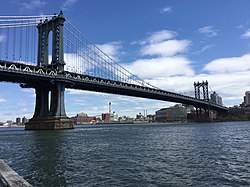Manhattan Bridge | |
|---|---|
 View from Manhattan towards Brooklyn, 2022 | |
| Coordinates | 40°42′25″N 73°59′26″W / 40.7070°N 73.9905°W |
| Carries |
|
| Crosses | East River |
| Locale | New York City (Manhattan–Brooklyn) |
| Maintained by | New York City Department of Transportation |
| ID number | 2240028 (upper) 2240027 (lower)[1] |
| Characteristics | |
| Design | Suspension bridge |
| Total length | 6,855 ft (2,089 m) |
| Width | 120 feet (37 m)[2] |
| Height | 336 ft (102 m) (towers)[2] |
| Longest span | 1,480 feet (451 m)[3] |
| Clearance below | 135 ft (41.1 m)[2] |
| History | |
| Designer | Leon Solomon Moisseiff[2] |
| Constructed by | Othniel Foster Nichols[2] |
| Construction start | 1901[2] |
| Construction end | 1909[4] |
| Opened | December 31, 1909[4] |
| Statistics | |
| Daily traffic | 67,851 (2019)[5] |
| Toll | None |
| Designated | August 30, 1983[6] |
| Reference no. | 83001694 |
| Designated entity | Manhattan Bridge |
| Designated | July 6, 1983[7] |
| Reference no. | 04701.000010 |
| Designated | November 25, 1975 |
| Reference no. | 0899 |
| Designated entity | Manhattan Bridge Arch and Colonnade |
| Location | |
 | |
The Manhattan Bridge is a suspension bridge that crosses the East River in New York City, connecting Lower Manhattan at Canal Street with Downtown Brooklyn at the Flatbush Avenue Extension. Designed by Leon Moisseiff and built by the Phoenix Bridge Company, the bridge has a total length of 6,855 ft (2,089 m). It is one of four toll-free vehicular bridges connecting Manhattan Island to Long Island; the nearby Brooklyn Bridge is just slightly farther west, while the Queensboro and Williamsburg bridges are to the north.
The bridge was proposed in 1898 and was originally called "Bridge No. 3" before being renamed the Manhattan Bridge in 1902. Foundations for the bridge's suspension towers were completed in 1904, followed by the anchorages in 1907 and the towers in 1908. The Manhattan Bridge opened to traffic on December 31, 1909, and began carrying streetcars in 1912 and New York City Subway trains in 1915. The eastern upper-deck roadway was installed in 1922. After streetcars stopped running in 1929, the western upper roadway was finished two years later. The uneven weight of subway trains crossing the Manhattan Bridge caused it to tilt to one side, necessitating an extensive reconstruction between 1982 and 2004.
The Manhattan Bridge was the first suspension bridge to use a Warren truss in its design. It has a main span of 1,480 ft (451 m) between two 350-foot (110 m) suspension towers. The deck carries seven vehicular lanes, four on an upper level and three on a lower level, as well as four subway tracks, two each flanking the lower-level roadway. The span is carried by four main cables, which travel between masonry anchorages at either side of the bridge, and 1,400 vertical suspender cables. Carrère and Hastings designed ornamental plazas at both ends of the bridge, including an arch and colonnade in Manhattan that is a New York City designated landmark. The bridge's use of light trusses influenced the design of other long suspension bridges in the early 20th century.
- ^ "NYC DOT Bridges & Tunnels Annual Condition Report 2015" (PDF). City of New York.
- ^ a b c d e f Manhattan Bridge at Structurae
- ^ Cite error: The named reference
jacksonwas invoked but never defined (see the help page). - ^ a b "Manhattan Bridge Opened to Traffic – Mayor McClellan's Last Act in Public Was to Lead a Procession on Wheels Across – Brooklyn Men Celebrate – New Structure Has the Largest Carrying Capacity of Any Crossing the River – The Span Is 1,470 Feet" (PDF). The New York Times. January 1, 1910. ISSN 0362-4331. Retrieved December 24, 2017.
- ^ "NYC DOT – Data Feeds". New York City Department of Transportation. 2019. NYC Bridge & Screenline Traffic Volumes Dashboard. Retrieved May 21, 2022.
- ^ "National Register Information System". National Register of Historic Places. National Park Service. November 2, 2013.
- ^ "Cultural Resource Information System (CRIS)". New York State Office of Parks, Recreation and Historic Preservation. November 7, 2014. Retrieved July 20, 2023.